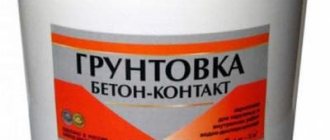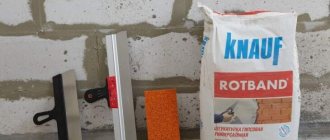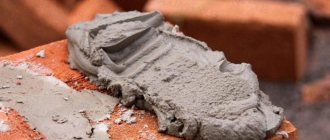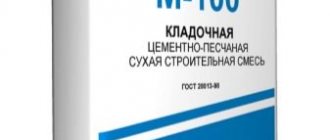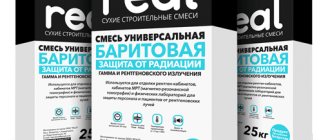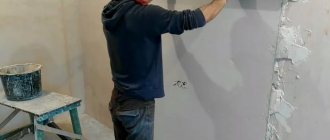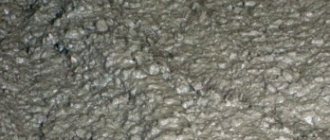Rotband plaster is a multifunctional gypsum mixture that contains polymer impurities that increase adhesion (adhesion). This technical characteristic allows the mixture to adhere to the base.
The main task is manual plastering with high quality, ceilings, walls from bases which are concrete, brick, polystyrene foam, cement. It is recommended to use in rooms where humidity is normalized. Gypsum absorbs moisture very well.
Works especially well on smooth concrete surfaces, vertical and horizontal. Knauf Rotband gypsum plaster has universal instructions on the bag. Therefore, there should be no problems. If it is torn or sealed, then read it on this page.
Scope of application of Rotband plaster
It is a universal building material.
It is mainly used for leveling concrete, brick and cement surfaces. But it can also be successfully used for plasterboard partitions. This type of plaster is used only for interior work.
In general, the main functions of plaster are:
- decorative;
- protective;
- technical.
The decorative function involves the creation of aesthetic forms.
External plaster is performed to insulate a building, protect it from negative environmental influences, or for decorative finishing.
The protective function is that the plaster avoids excess humidity in the room and is able to maintain the required temperature.
The technical function is that it allows you to use plaster to create a perfectly smooth surface for subsequent painting or wallpapering.
To properly use this type of plaster, it is necessary to study its technical characteristics.
Analogues. What's better?
It is worth noting that there are several types of gypsum-based dry plaster on the construction market. Therefore, if you wish, you can choose a good alternative to Rotband. However, how feasible would such a replacement be? To answer this question, you need to compare the characteristics of the most popular plaster mixtures.
"Volma" or "Rotband"
If we talk about technical characteristics, there is no significant difference between the mixtures. At the same time, Volma is much cheaper, which promises financial benefits for large volumes of work. In addition, “Rotband” is often counterfeited, so even at a high price you can buy a low-grade counterfeit.
"Teplon" or "Rotband"
Comparing these mixtures, you can notice the difference in price: “Rotband” will cost significantly more. At the same time, the consumption of "Teplon" looks more economical - 4.5 kg/m2 . In terms of quality, “Rotband” looks more attractive, so if your budget allows, it is better to give preference to this particular plaster.
"Goldband" or "Rotband"
The mixtures are produced by the same company, so they have no fundamental differences in price and quality. However, in the field of application the difference becomes noticeable. In particular, Rotband has better adhesion, so it can be used to level rough and smooth surfaces. The analogue does not have this feature, therefore it is used only for rough walls, which initially provide high adhesion of materials.
In general, “Rotband” can be replaced with an analogue, especially if the issue of price plays a decisive role.
Colors
Before purchasing, you should decide on the shade.
The main plants producing plaster:
- gray plaster (Krasnogorsk);
- white - “Knauf Gips Kuban” (Krasnodar Territory and Astrakhan Region);
- pink - “Knauf Gips Chelyabinsk” and “Knauf Gips Kolpino”.
The color is usually not indicated on the packaging. You can determine the color by the manufacturer. It should be noted that the finished mixture, depending on the shade, may behave differently . After applying a layer of Rotband plaster in white or gray shades, it flows off, as a result of which horizontal waves can form.
This defect is not observed when using pink plaster.
This phenomenon of the solution can be explained by the granularity. Pink plaster has large grains up to 1.2 mm, while white and gray shades have smaller grains - about 0.5 mm . Experts recommend using Rotband in white or gray shades to level the walls and then apply wallpaper without putty.
Manufacturer
The developer and copyright holder of Rotband plaster mixtures is the German company Knauf Gips KG.
The company was founded in 1932, in 1949 it built the first plant for the production of gypsum mixtures for construction, and in 1958 - a plant for the production of sheet plasterboard. Its area of activity is the production of dry plaster mixtures, plasterboard building sheets, as well as fiberglass insulation materials.
Given the great popularity and widespread use, Knauf plaster. Rotband" with the participation of German partners is produced by enterprises located in the territories of many European countries, including domestic enterprises in St. Petersburg, Chelyabinsk, Astrakhan, Moscow regions, Krasnodar Territory.
Layer thickness
The Rotband brand assumes the consumption of gypsum plaster is 2-3 times less than cement plaster.
The minimum layer thickness is 5 mm . It is recommended to apply a layer thickness of 10 mm, but if necessary, the value can be increased. For example, on ceilings the permissible layer thickness is 15 mm, on walls – 50 mm.
It is necessary to take into account that if a thick layer is required, it is recommended to carry out the work as follows: applying the first layer (up to 50 mm), drying, priming, applying the second layer, etc.
Briefly about the main thing
As mentioned earlier, rotband plaster is very economical. If you know how to work with similar materials, you can use it as a starting and finishing layer.
Therefore, the surface of the wall and ceiling will be fully prepared for further decorative work. Rotband is a safe material because gypsum and polymer additives are used in its production. Applying the solution to walls is easy and is also suitable for beginners.
The only downside of rotband is that it hardens quickly. Therefore, work must be carried out quickly. At first, try to prepare the composition in small portions. Before using the rotband, you can practice a little on a hidden area of the wall. It is necessary to fill your hand so that the application goes “smoothly”.
Thermal conductivity
The thermal conductivity of the mixture is 0.25 W/m . This is a fairly low figure. The mixture stabilizes humidity and maintains optimal temperature in the room.
From the characteristics discussed above, we can conclude that Rotband is an ideal option for finishing premises.
Additional technical characteristics of the plaster can be found in the table:
| Table of main technical characteristics of gypsum plaster "Rotband" | |||
| Technical specifications | Unit | Magnitude | |
| Working temperature | WITH | 5 – 30 | |
| Thickness of applied layer | minimum | mm | 5 |
| maximum | 50 | ||
| recommended | 10 | ||
| Consumption of dry plaster mixture with a layer thickness of 10 mm | kg/m2 | 8,5 | |
| The amount of solution obtained from one bag weighing 30 kg | l | about 40 | |
| Time | solution maturation | minute | 10 |
| life of the solution in an open container | 20 – 25 | ||
| drying of a layer 10 mm thick | 45 – 60 | ||
| full strength gain | day | 7 | |
| Density | dry mixture | kg/m3 | 730 |
| dried plaster | 950 | ||
| Strength of hardened plaster | bending | MPa | more than 1.0 |
| for compression | more than 2.5 | ||
| Grit size | mm | up to 1.2 | |
| Plaster color | – | white, gray, pink | |
| Shelf life in undamaged packaging | month | no more than 6 | |
How to plaster correctly. Instructions for use
You need to be able to work with any building material, otherwise even a high-quality mixture will not cope with the functions assigned to it. Accordingly, you will have to forget about the quality of finishing. In the case of Rotband, detailed instructions for use are indicated on the packaging. However, it makes sense to focus on key points that will be useful for beginners and others.
How to breed. Proportions and procedure
Rotband should be stirred in a clean plastic container. The plaster must be diluted in a ratio of 2:3 for liquid and dry matter, respectively. As a result, a 30 -kilogram bag will require about 18 liters of water.
The mixing order will be as follows: first pour in water, then gradually add plaster. The composition is constantly stirred until a viscous homogeneous mass is obtained.
The mixture hardens quite quickly: the lifespan of the mixed solution in an open container is about 20 minutes . Therefore, the best option would be to prepare the plaster in small portions.
Preparing the surface for work
In order for the plaster to lay down in an even layer and not crack after drying, you need to prepare the wall. To do this, it is necessary to clean the previous coating, remove dirt and greasy stains, and treat metal elements with anti-corrosion compounds.
To increase the adhesion of the plaster to the wall and uniform drying, the surface must be primed. Having prepared the wall, beacons are installed on the surface, which will simplify the plastering process.
How to apply “Rotband” to the wall
For the plastering process, it is better to use a wide spatula as in the photo. The solution is applied between the installed beacons, covering the surface about a meter high. Then the mixture is pulled out using the rule, performing zigzag movements.
It is important to consider that the rule is from the bottom up, repeating the movement several times, otherwise the solution may settle.
The recommended layer thickness is 10 mm , however, this will not be enough for uneven walls. Therefore, after the first layer has dried, apply a second one, following a similar algorithm.
Surface leveling and grouting
30-40 minutes after application, the plaster will have set, so you can proceed to the final stage - leveling. To do this, you will need a metal strip, which can be used to remove irregularities formed during the work. After this, grouting is performed.
The wall and grout are moistened with water and unevenness is smoothed out, making circular movements with minimal pressure on the wall.
Four questions that concern buyers most
- Material consumption per 1m2
- How long does it take for the treated surface to dry?
- Is it possible to glue wallpaper directly onto plaster?
- Can tiles be laid directly on a plastered wall?
| KNAUF - Rotband, kg/m2 | 8,5 |
| KNAUF - Betokontakt, kg/m2 | 0,3 |
| KNAUF Rotband - Grund, kg/m2 | 0,4 |
| KNAUF - Grundirmittel, kg/m2 | 0,1 — 0,15 |
One bag of dry mixture (30 kg) is enough to plaster a wall area of ~3.5 m2 .
Drying time depends on the thickness of the applied layer. In particular, the thickness of the plaster layer recommended by the manufacturer is about 10 mm . If these conditions are met, the solution will take about an hour to dry. In order for the plaster to gain the declared strength, you will have to wait 7 days .
Plastering the walls is not the last stage of work. When the solution dries, finishing is performed. Two types of building materials are usually used here: tiles and wallpaper. Therefore, many novice builders are concerned with the question: “Is it possible to glue wallpaper on Rotband?” This option is acceptable, provided that the grouting has been done and the wall has been treated with a primer. You can use regular glue.
Here, too, you can answer in the affirmative, however, preparation for finishing will be different. In particular, a minimum of three coats of primer will be required. This will require deep penetration compounds. Each layer should dry for about 6 hours , so you can start laying the tiles only after a day.
Method of preparation for work
You need to mix the plasters as much as you can produce in 25 minutes.
It should be noted that the gypsum mixture is demanding to handle. Therefore, it is necessary to carefully study the features of the work. It is not recommended to use Rotband in rooms with very high humidity levels, because... Over time, it may become wet and fall off.
The plaster solution dries quickly, so work should be completed within 20-25 minutes . Almost two days after complete drying, you can proceed to further finishing.
The room temperature should not be lower than +5 degrees . On the day of work, it is necessary to ensure the complete absence of direct sunlight and only after a day can the room be ventilated.
The preparation of the solution is as follows:
- Fill a plastic container with approximately 18 liters of cold water (for a package weighing 30 kg);
- add 5–7 trowels of the mixture to the water;
- to stir thoroughly;
- pour out the rest of the mixture from the package;
- mix with a plaster mixer until smooth;
- leave for five minutes;
- Stir again, add water if necessary.
The consumption of Rotband plaster per 1 m2 is 8.5 kg. with a layer thickness of 10 mm. From one package you can get 36 liters of solution .
Features of packaging and storage
As mentioned earlier, rotband is packaged in bags of different weights. The bags are made of paper. Despite this, they do not accumulate condensation, which is why the composition is preserved for a long time.
Storage is recommended in rooms with low humidity. It is better to use wooden pallets.
If the bag is open or damaged, try to use it first.
Rotband can be stored in undamaged bags for up to six months.
Working methods
The following working techniques will help you cope with it as comfortably as possible:
- Apply the prepared solution to the wall with a thickness of 5-10 mm;
- spread with plaster falcon from bottom to top;
- smooth out using a zigzag motion;
- after the solution begins to harden (45-60 minutes), level it with a metal spatula, cutting off the excess and filling the recesses;
- after 15 minutes, sprinkle the plaster with water;
- rub using a stiff sponge or felt grater;
- remove irregularities;
- after a matte effect appears on the surface, the plaster must be smoothed with a spatula or metal trowel;
- To obtain different textures or patterns, you can structure the surface.
To do this, walk over the not yet hardened surface with a relief roller or a hard brush.
Advantages
Gypsum mortar is almost an ideal building material.
Gypsum is a soft and fairly flexible material
Among the advantages the following can be noted:
- After treating the surface with this mixture, it does not need to be putty;
- crack resistance;
- low consumption;
- regulation of moisture in the room;
- environmental friendliness;
- the solution does not dehydrate and does not separate;
- a smooth surface is achieved;
- dries quickly;
- convenient to use.
But, despite the fact that Rotband is an ideal mixture, it has a number of disadvantages.
Differences from fake
Today, unscrupulous sellers, for the purpose of profit, can sell a fake at the price of the original Rotband.
The purchase of such goods is fraught with discrediting the building material, since in the future the demand for it will be lost.
That is why, in order to avoid further adverse consequences, the Knauf company took care of its reputation.
It was decided to pack the plaster in unique bags. They are made from corrugated paper. The production of bags is carried out only by order of the Knauf company. This means that other brands may not have them. Second-by-second markings are also applied to the bags.
This means that each package contains information about the exact production time. Therefore, you will not be able to find two identical packages on the market. The Knauf company also puts a hologram on the bags. It changes color if you rub it a little.
Price
Rotband plaster has a fairly high price, since the Knauf company is very popular in the building materials market, but the quality of the mixture is really good.
The average price is from 350 rubles. for 30 kg . It is recommended to store the mixture in a dry place on a wooden pallet. The shelf life is 6 months .
You can come across fakes on the market. If sand is found in the packaging, this is a clear sign of fraud . Therefore, when purchasing a large batch, it is recommended to pay attention to the date stamp and the presence of a hologram on the packaging.
More information about Rotband gypsum plaster and its technical characteristics can be viewed in the video:
Packaging and expiration date
“Rotband” is sold in paper bags weighing 5-30 kilograms (see photo at the beginning of the article). Thanks to this packaging, builders can purchase only the required amount of material without overpaying for excess.
If we talk about shelf life, this parameter is 6 months . The data is indicated by the manufacturer on the packaging. It should be clarified that a six-month shelf life is possible provided that the mixture is in undamaged packaging. If the container is open, it is better to pour the plaster into an airtight container and store it in a dry room.
The specified shelf life of 6 months is not critical. According to professional builders and finishers, one-year-old plaster is also suitable for use.
However, it is better not to use such material in critical areas of work: there is no guarantee that cracks will not appear. In addition, expired “Rotband” hardens faster, which means it will be harder to work.
